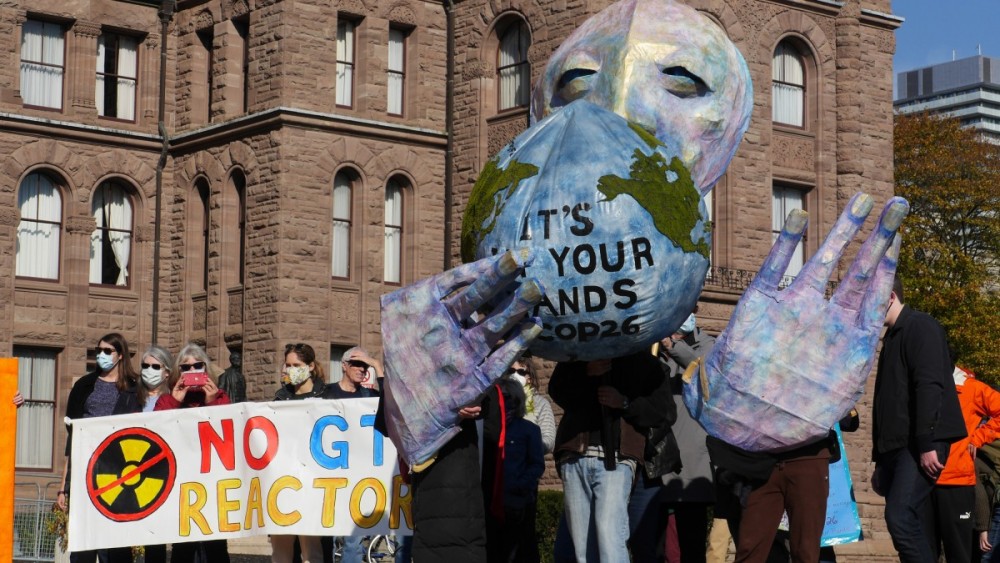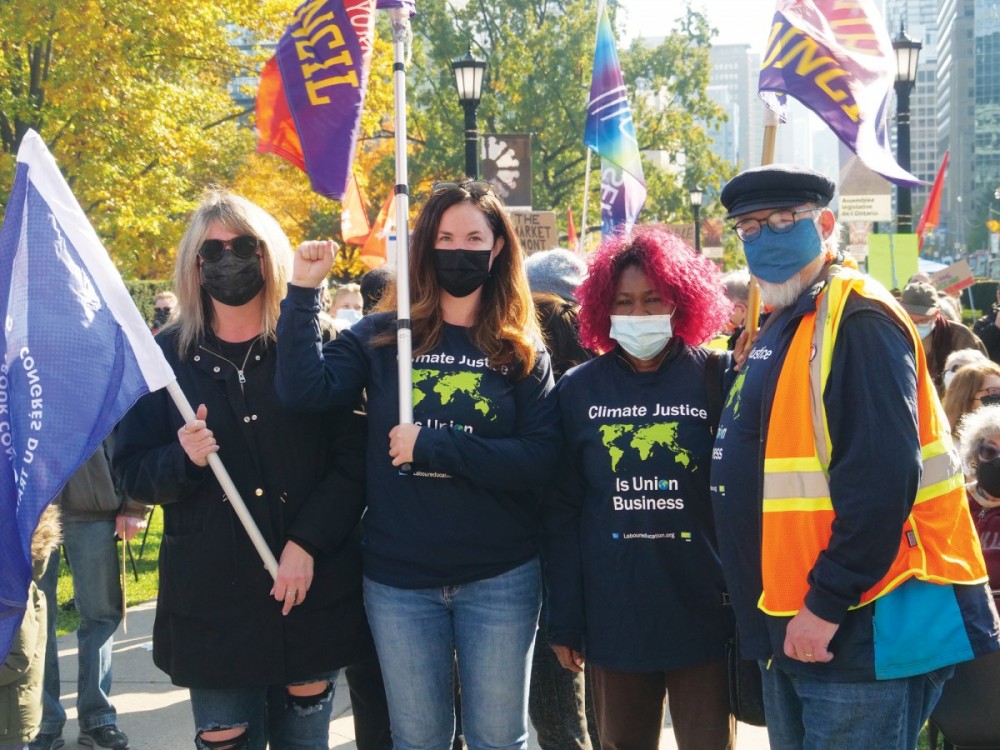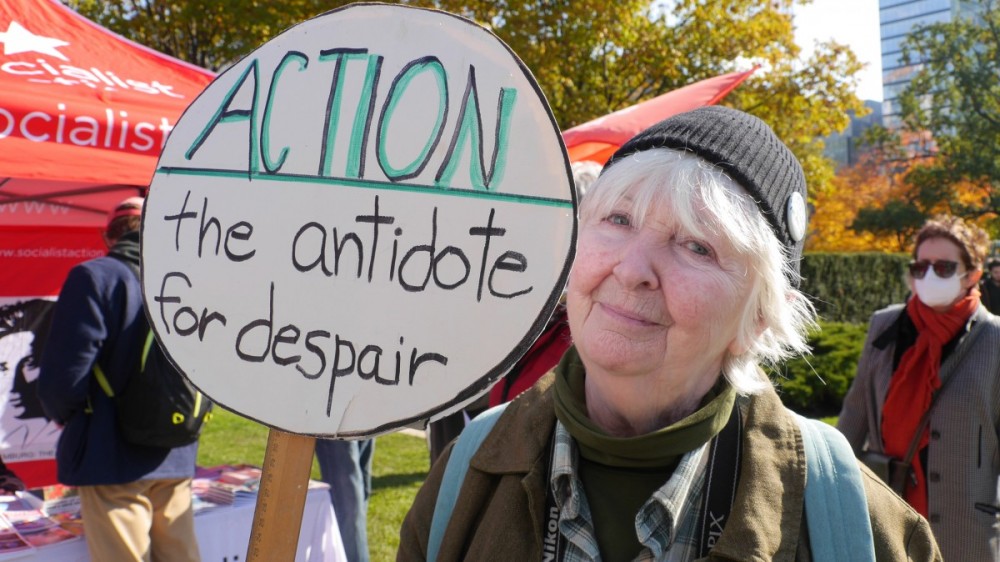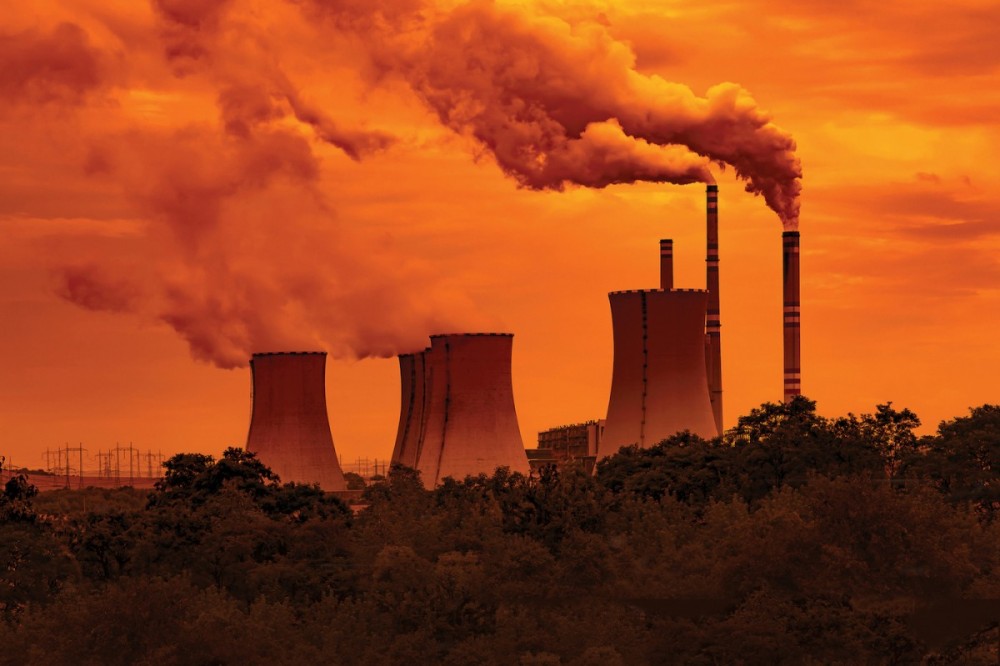Many experts believe that coal generation needs to be phased out as soon as technically possible, regardless of coal reserves, and that any use of fossil fuels including natural gas to generate electricity will have to end globally by 2040. — from “Just Transition: Exactly What’s in it for Workers?”
The compelling story of coal-fired electricity plant closures in Australia, as recounted at an International Confederation of Trade Unions workshop in October 2017, inspired Toronto’s Labour Education Centre (LEC) to conduct four case studies on Just Transition from a worker’s point of view.
Called “Just Transition: Exactly What’s in it for Workers?,” LEC’s project examines the extent to which workers’ interests were considered before, during, or after the closure or conversion of coal plants in four places — Alberta, Ontario, and the Australian states of South Australia and Victoria.
The Politics of Plant Closures
Alberta, Canada
Globally, Alberta is known for its oil and gas industry, and its controversial mining of carbon-rich bitumen, traditionally called tar sands, but rebranded oil sands.
The former Harper federal government had established 2030 as the deadline for phasing out most coal-fired electricity. When the Trudeau government was elected it continued to move the province toward using cleaner sources of energy, mainly gas. In an effort to stave off capital flight and to hasten the coal-plant closures, the NDP government of Alberta then paid $1.36 billion to three energy companies, although some of the plants were relatively new and efficient.
Compensation was given to the companies without including any compensation to workers or communities as part of the closures. The government also failed to consult with affected communities and workers before announcing the closures and negotiating with the power companies.
But after hearing from municipalities and unions about the lack of programs for communities and workers, in September 2016 the Alberta government did establish an advisory panel to examine potential impacts of the coal phase-out and to identify ways to support worker transition. The panel was tasked to consult with coal workers and their unions, communities, municipal and First Nations leaders, small businesses and community organizations responsible for economic development. The advisory panel’s 35 recommendations to the government were released in September 2017.

Climate justice activists rallied in Toronto on November 6 as part of the Global Day of Action for Climate Justice, which coincided with COP26 (the international climate summit) in Glasgow, Scotland. PHOTOGRAPH: ELIZABETH LITTLEJOHN
Meanwhile, Alberta Federation of Labour (AFL) president Gil McGowan took a leading role in persuading the provincial government to correct its initial mistake. The AFL created the Coal Transition Coalition, which became an effective advocate for the workers and their communities, hosting town hall meetings and talking with workers, their unions and their families. The coalition published a report in March 2017 that included transition case studies, best practices and lessons that might be useful for Alberta’s transition away from coal power. Many of the recommendations from the coalition’s research were mirrored in those submitted to the provincial government by its advisory panel.
The government’s financial, employment and retraining programs for workers began operating in January 2018. This was after policy advisors presented Premier Notley with a list of supports for workers and were told to come up with a better plan. When they did, that improved plan proved to be the most comprehensive of any of the four cases examined by LEC.
In 2019, a United Conservative Party (UCP) government was elected in Alberta, resulting in some transition supports being cancelled, though the phasing out of Alberta’s coal-fired electricity plants continues. Companies themselves are accelerating the timeline even more. Capital Power Corp of Edmonton, for instance, has committed to phasing out coal entirely by 2023.
Ontario, Canada
In Ontario, high emissions from coal plants generated a grassroots movement motivated by health concerns. In 2003, that movement helped bring in a Liberal government committed to a “green agenda.” The Liberals stayed in power long enough to close Ontario’s last five plants between 2005 and 2014.
Some of the plants had been modernized, which contributed to the two unions representing plant workers and technical staff choosing to join forces with the management of the publicly owned utility to oppose the shutdowns, rather than negotiate a better transition for the workers. No special provisions were made for workers or communities in the case of the Ontario shutdowns, other than those already stipulated in the workers’ collective agreements.

(Left to Right): Kim Kent (CLC Ontario Region), Heather Erlen (CLC Ontario Region), Andria Babbington (Toronto & York Region Labour Council), Steve Shallhorn (Labour Education Centre). PHOTOGRAPH: NADINE MACKINNON
Much of the Liberals’ green agenda did not materialize, but some important gains were made. These included bringing in solar and wind power development, putting in place protections for much of Ontario’s green space, providing incentives for residents to make homes energy efficient, and, in partnership with Quebec and California, instituting a cap-and-trade program on January 1, 2017. The carbon price was yielding billions of dollars that were then distributed to Ontario school boards, hospitals, municipalities, community organizations and green industries for the purpose of upgrading aging infrastructure, retrofitting older buildings and implementing other measures to reduce greenhouse gas (GHG) emissions.
But days after coming to power in June 2018, Doug Ford’s Conservative government cancelled the cap-and-trade program and these funding initiatives. The Ford government also challenged the federal Liberals’ national carbon tax in court, though, in March 2021, the Supreme Court ruled to uphold the federal legislation. Since then, Ford has introduced only a very weak provincial carbon-pricing program based around facilities, rather than industries.
Port Augusta, South Australia
A grassroots movement also preceded the May 2016 closure of the Northern Power Station in Port Augusta, located in the state of South Australia. The group Repower Port Augusta, comprising activists, union leaders and the local city council, was able to convince the community that the future lay in renewable energy. In a public, non-binding referendum, people voted overwhelmingly to support a transition from thermal coal to thermal solar, and Repower Port Augusta marched on the state capital of South Australia to keep the issue alive.
In the end, though, the closure had less to do with community protest, and more to do with the cost of an aging plant and the state of wider energy markets. Alinta Energy, the operator, closed the plant after the South Australian government refused to provide the subsidies demanded by the company to keep it operational. The closure caught all parties by surprise and tested the local coalition, in part because union leaders had not prepared their members for such an outcome.
After the closure, South Australia’s Labour government eventually agreed to purchase electricity from a solar thermal plant at a set price, attracting an American firm to build a facility there similar to one it had already constructed in the U.S. state of Nevada. But obstacles appeared. Financial challenges arose with the future plant, and technical problems became apparent at the existing Nevada plant. A change of government at the state level in 2018, to the right-leaning Liberal Party of Australia, led to the cancellation of the solar plant in April 2019.
The new state government instead decided to invest in a high-capacity interconnector link between South Australia and New South Wales. These high-voltage cables connecting different electricity systems came at a cost of double the funds that would have been needed to build the solar farm.
Australia was one of the first countries to introduce a price on carbon through a cap-and-trade system, in 2011, and, when its federal government changed from Labour to the Liberal-Nationals in 2013, one of the first to withdraw that initiative. Meanwhile the machinations of Australia’s current conservative coalition government on climate and energy policy are legion.
Despite progress being stymied at the federal level, local will and local government, not to mention an abundance of sun, have led to Port Augusta becoming a global centre for solar energy, providing some new jobs for workers. But the thermal solar plant, another victim of government vicissitude, has yet to materialize.
Latrobe Valley, Victoria
Located in the Latrobe Valley, the Hazelwood coal-fired gas plant was the dirtiest in Australia and one of the dirtiest in the world. Environmental groups had long advocated for its closure and, as early as 2007, unions initiated a series of Climate Change Forums, which met locally to discuss the future of Hazelwood. The plant was one of five slated to be shut with federal funding under a Labour government. This program, called Contract for Closure, would have helped the employer, workers and community through the phase-out. But a breakdown in negotiations stalled the initiative and, by 2012, the plans had been scrapped by the Labour government.
As in Port Augusta, the change of federal government in 2013 from Labour to the conservative Liberal-National coalition halted any progress. The new government ended the Contract for Closure program. But when an underground fire erupted in 2014 at the adjacent coal mine and burned for weeks, causing severe air quality issues, more calls came for the plant to close.
In the end, the Hazelwood plant’s demise in March 2017 came not because of any decision by Australian politicians or the local community. It was the result of decisions made in Paris (and presumably to some extent in Tokyo). At the time of the closure, 72 per cent of the Hazelwood plant was owned by the large French multinational utility ENGIE, which in 2015 had announced its intention to divest its fossil fuel holdings and invest in renewable energy. The other 28 per cent was owned by Mitsui, a large multi-sector Japanese company.
The community, though, undertook planning for Hazelwood’s closure. When the plant was shuttered, the Victoria state government poured millions into local workforce development and regional development initiatives while continuing to invest in renewable energy.
Other plants in the Latrobe Valley, namely the Loy Yang Power Station A and Station B, and the Yallourn W Power Station, continue to burn high-carbon brown coal. The latter saw a fire break out at the station’s coal distribution facility in November 2021. The fire was extinguished quickly, but residents were once more exposed to harmful toxic smoke.
Similarities and Differences Between the Cases
Just as the increasing number of smog days in Ontario led to activists there pointing to effects on respiratory health, the move away from coal in Alberta was prompted in part by air-quality concerns. In both places, the closure of coal-fired electrical plants became a plank in the election platforms of campaigning political parties. Once elected, both governments understood the need to reduce emissions efficiently and rapidly.
In both these cases, though, it has taken years for the plants to close or be phased out. Affected workers have faced long periods of concern and anxiety, job loss and displacement, and the loss of local revenue.

“The crisis will not be solved if those most affected are not central to the solutions and decision-making.” PHOTOGRAPH: ELIZABETH LITTLEJOHN
Neither government had a transition plan ready, or even in preparation, when closures were announced. In Ontario, after the initial closure of the coal-burning Lakeview Generating Station in 2005, the long gap to close the remaining four plants did not result in a transition plan, just a continued reliance on the collective agreements of the two unions. In Alberta, a good plan was eventually put in place by the government before the lay-offs started, but only after a barrage of criticism from affected municipalities, workers and the labour movement, particularly the Alberta Federation of Labour.
In contrast to the election-driven campaign promises made in Canada, the two Australian closures were the result of corporate decisions that, when announced, left governments scrambling to pick up the pieces. In both these cases, changing energy markets combined with old inefficient plants had more to do with the plants shuttering than did any long-standing public opposition.
The time between announcement and actual closure was relatively short in each Australian case — just five months for Hazelwood, and 11 months for the Northern Power Station.
As for the approaches taken to transitioning workers, in all four cases, older workers, for the most part, took early retirement or redundancy packages and left the workforce.
One innovative approach taken in the Latrobe Valley, first used in Germany, saw older workers from neighbouring plants offered early retirement to make room for younger workers transferring from Hazelwood. This kind of approach could become more important in the future, not only for the phase-out of coal, but also in oil and gas fields, where, due to economies of scale, closure is likely to happen on a plant-by-plant basis, rather than through each plant reducing production by 10, 50 or 80 per cent.
But caution is needed. It was difficult for LEC to determine how effective this approach actually was. While it seems that more than half of the 150 budgeted transfers in Latrobe did indeed take place, certain neighbouring plants may have filled some of their vacancies with non-Hazelwood workers who were willing to work for lower wages. This raises the question of enforceability, and whether workers can have confidence that Just Transition measures such as these are actually just in practice.
The October 2018 conference of Blue Green Canada in Edmonton, Alberta, included coal miners who were members of the United Steelworkers (USW). While still working, most were expecting to receive lay-off notices within a few months. An issue they raised was that eligibility for transition funding, including retraining, would not be available until they were actually laid off. This caused concern for two reasons.
Those interested in a retraining grant felt they should be able to register in advance for a course, to decrease the lag time between their last day of work and their first day of retraining. They were also concerned they would no longer benefit from peer-to-peer support after their last day of work, because they would be without day-to-day contact with co-workers and union leaders. Research done elsewhere on closures has shown that workers transition better to training and/or education programs if they can access these opportunities before actual layoffs occur.
In all four cases, government, communities and unions were unprepared to provide anything close to a timely Just Transition when the plant closures were announced. And in all four cases, the transition away from coal-fired plants to GHG-free sources of energy has been anything but straightforward. In both Ontario and Alberta, for example, one of the unintended results was an over-production of natural gas–fired electricity generation.
Workers, their Unions and Green Jobs
In most of these cases, the coal-fired plants were the main or major economic drivers in their communities. The companies paid taxes and sponsored various local initiatives. Employees owned homes, paid taxes and supported local businesses. Many of the affected workers had to leave their communities to find commensurate employment; many never again found jobs with comparable salaries and benefits.
A factor that is alluded to but not explicitly stated in several case studies is the effect closure has on the mental health of workers and their families. In Hanna, Alberta, news of the impending closure of the nearby Sheerness coal mine and plant caused a dramatic escalation in domestic violence and a demand for social workers and additional social services, as documented by local authorities including the Royal Canadian Mounted Police. This phenomenon is undoubtedly present in all of these communities and is a consequence that needs to be understood and anticipated so that appropriate services are part of the closure plan.

“We need climate action that works for all of us, not just people with the most money in their pocket.” Music and arts performances were part of the program. PHOTOGRAPH: ELIZABETH LITTLEJOHN
Over 5,000 workers were directly affected by these closures in Canada and Australia, and thousands more were impacted indirectly. Suppliers were hit with job losses; communities, with economic disruption. Families and members of close-knit communities were separated from one another. Many families also had generations of workers employed in these plants. Generations of Port Augusta residents, for example, worked in the coal-fired plants, which supplied good, stable jobs in the community for over 60 years, but at great cost to the community’s health and to the environment.
One estimate noted that over 50,000 jobs could ultimately be affected by the 2017 Hazelwood plant closure. This includes the workers in the plant itself, its subsidiaries, plant suppliers, and local businesses that depended on the workers’ salaries.
It bears emphasizing that in almost every scenario, creating transition plans and looking after former employees were the last elements to be considered by governments and management, and even then, came about only as a result of intense public pressure.
One of the clear lessons for the unions involved in Port Augusta was that union leaders should start conversations with their members much earlier in the transition process and be at the forefront of planning for Just Transition.
These conversations should provide workers with education about renewable sources of energy and help them identify those skills and abilities which will aid them in transitioning into good, green jobs. To be fair, in Port Augusta, the company’s announcement caught everyone by surprise. Thankfully, the earlier and substantial work the union leadership had done with local environmental groups saved the community from being ripped apart.
In Alberta, it was the AFL’s Coal Transition Coalition that made all the difference to the strength, and the very existence, of the province’s transition plans. Government sources have since acknowledged that workers and their union representatives should have been consulted much earlier in the closure process.
In Ontario, as mentioned, no programs were put in place for workers or communities. Only strong collective agreements with provisions for intra-company transfers and training already in place gave workers any justice.
Unionization Matters
A theme that emerged throughout the study is that the coal plants and coal mines are unionized, and that new renewable energy industries, namely green jobs, generally are not. What must be pointed out, though, is that unions did not just suddenly materialize in coal mines or coal-fired plants. Coal mining unionization drives, especially, have often been violently contested.
One need only look at the many storied strikes in Canada, Australia and elsewhere to learn this history. In Canada, the Nova Scotia strikes of the 1920s against wage reductions by the British owners forced federal and provincial governments to bring in conciliatory labour policies and strengthened the power of labour unions in the country.
In Australia, a series of strikes and violent conflicts in the 1890s took place around coal mines in Broken Hill, New South Wales. In the U.S., the Appalachian miners’ strikes in Alabama and West Virginia culminated in the Matewan Massacre of 1920 and the Battle of Blair Mountain in 1921.
Many of these events have been recounted in story and song, with the U.S. coal miners’ struggles depicted in Michael Apted’s 1980 film Coal Miner’s Daughter and John Sayles’ Matewan, released in 1987. Billy Elliot and the 2014 film Pride are both set against the backdrop of the year-long miners’ strike that took place in Britain in 1984.
The Labour Education Centre’s four case studies offer examples of both positive and negative outcomes of transitions away from coal. In all instances, many of the workers are still facing unemployment, and the loss of good, stable jobs with benefits and pensions. There is massive community upheaval and social disruption. LEC is confident, though, that the labour movement can play an important role in Canada’s shift to cleaner, sustainable sources of energy.
As our economy shifts away from fossil fuels and more workers are affected by plant closures in the battle to reduce emissions, it is critical that the lessons learned from these case studies, and others, ensure that Canada’s workers experience a truly fair and just transition. And it will be up to the labour movement, as it always has been, to organize workers in the renewable energy sector and other green industries.
The report was authored by Rick Ciccarelli, Karen Lior and Steve Shallhorn at the Labour Education Centre, Toronto. You can find the full report here.
LEC’s research on “Just Transition: Exactly What’s in it for Workers?” was made possible by the Adapting Canadian Work and Workplaces to Climate Change (ACW) network, based at York University and funded by the Social Sciences and Humanities Research Council.











